
total of 1483 Ryukyu-related items in 54 different museums have been verified in European collections. The bulk of these – in terms of numbers of museums and of items – is to be found in Germany: 529 items (35.7%) are found in 21 museums. The Netherlands follow, then come Austria, Switzerland, the United Kingdom, Norway and France. Here I’d like to take a look at some of the items from the possession of the Museum of Ethnology in Berlin. With its roots dating back as far as the 17th century, this museum opened in 1886 under the name of “Museum für Völkerkunde”.
“The Kingdom of Ryukyu was, from its beginnings in the middle ages up to 1879, besides the Yamato State, the Heian Court or the shogunates of Kamakura, Muromachi and Edo, the only other independent political entity on the Japanese Islands.” Josef Kreiner 1996
Its collection comprises a total of 508,000 ethnografika and archaeological objects. In addition, it houses 285,000 ethnographic photo documents, 200,000 pages of written documents, 140,000 ethnographic music and sound recordings, 20,000 ethnographic films and 50,000 meters of uncut footage. The Museum of Ethnology in Berlin is therefore one of the biggest museums of ethnology worldwide and constitutes the most comprehensive collection of its kind in Europe.
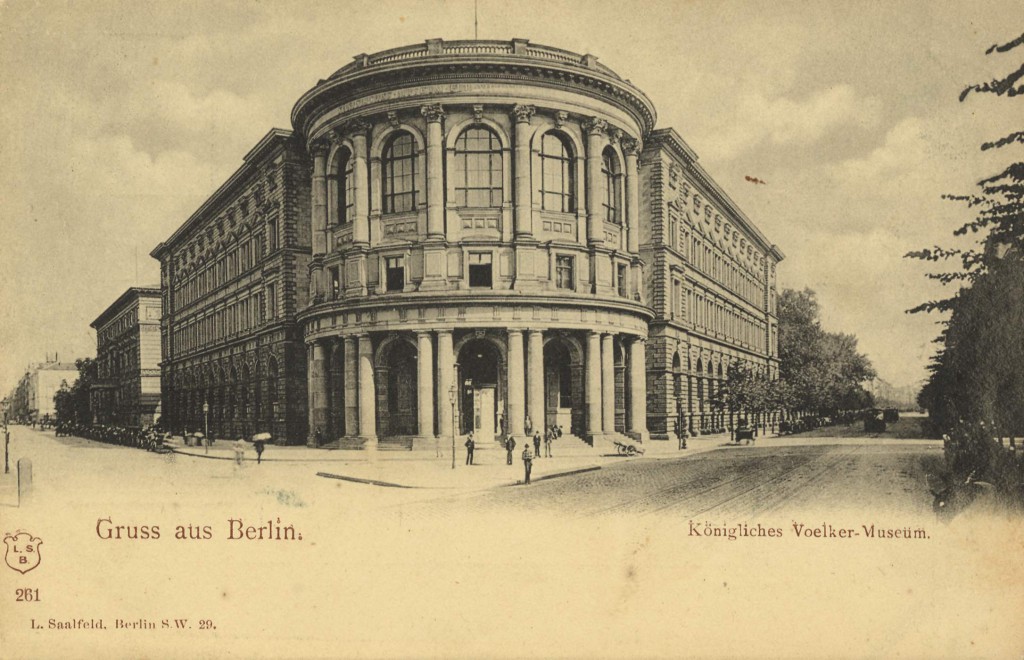
The Museum of Ethnology on a post card, around 1900
During the era of National Socialism, the Museum of Ethnology in its presentation did not ingratiate to the dominant ideology and was maintained almost unchanged.
Following the end of the war in 1945, the collections were confiscated by the Allies. The Western Allies returned the collection back to Berlin in the 1950s, while the Soviet Trophy Commission took their part to Leningrad as spoils of war.
After the reunification the collection divided to East and West Berlin were merged together again. From among the original 1 million+ items, the whereabouts of 25,000 objects remained unclear.
Since 2000, the relocation of the Ethnological Museum to the Humboldt Forum is planned.
As had been published by the Motobu-ryu, in 1884 alone the Museum of Ethnology in Berlin purchased 543 objects from Okinawa via the Japanese government. Among these were a yari (槍, spear) and a yamanata (山鉈, hatchet; yamanaji in Okinawan language), weapons and tools which are still used in Kobudo.
A list of items was provided in Kreiner 1996. According to it, among the more than 500 items found within German collections are:
- hairpins (kanzashi, jiifaa)
- hunting spear
- a saddle with red, green and yellow lacquer on wood and design of peonies
- hanging scrolls
- fishing gear
- caps of officials (hachimaki)
-
musical instruments (Sanshin, handdrums)
- sets of clothes from various social strata
- lacquer ware
- etc.
The following are Ryūkyū-related items from the digital collection of the Ethnological Museum in Berlin.
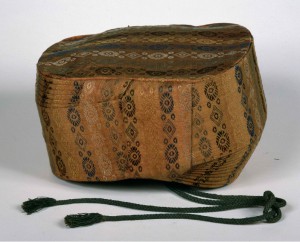
Hachimaki, © National Museums in Berlin, Prussian Cultural Heritage, Museum of Ethnology. Photographer: Claudia Obrocki.
Item: Officials headgear of originally red ground, interwoven with five colors of threads, from the royal court of Shuri
- Era: beginning of Meiji period, before 1883
- Place of origin: Ryūkyū/Okinawa, Naha City Shuri-jō
- Material: silk, pigment
- Measure: height: 10.0 cm, circumference: 64.0 cm
- Ident.Nr. I D 6823
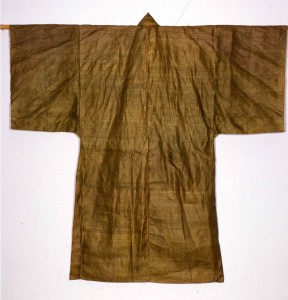
Winter court garb. © National Museums in Berlin, Prussian Cultural Heritage, Museum of Ethnology. Photographer: Claudia Obrocki.
Item: Winter court garb
- Era: beginning of Meiji period or earlier
- Place of origin: Ryūkyū/Okinawa, Naha City Shuri-jō
- Material: Banana fiber, herbal dye
- Length x width: 155 x 155,5 cm
- Ident.Nr. I D 6655

Hachimaki. © National Museums in Berlin, Prussian Cultural Heritage, Museum of Ethnology. Photographer: Claudia Obrocki.
Item: Officials cap (hachimaki)
- Era: beginning of Meiji period
- Place of origin: Ryūkyū
- Material: crepe, pigment
- Measure: Height: 10,0 cm, Circumference: 64,0 cm
- Ident.Nr. I D 6828
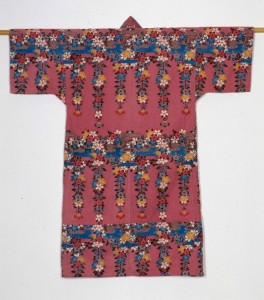
Ladies winter garb. © National Museums in Berlin, Prussian Cultural Heritage, Museum of Ethnology. Photographer: Claudia Obrocki.
Item: Winter garb of a lady at the royal court at Shuri
- Era: beginning of Meiji period or earlier
- Place of origin: Ryūkyū/Okinawa, Naha City Shuri-jō
- Material: Cotton, bingata
- Length x width: 134 x 125 cm
- Ident.Nr. I D 6678
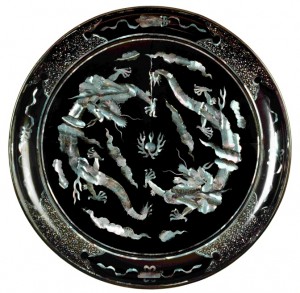
Lacquer tray. © National Museums in Berlin, Prussian Cultural Heritage, Museum of Ethnology. Photographer: Claudia Obrocki.
Item: lacquer ware tray with decoration of dragons among clouds
- Era: late 18th century
- Place of origin: Ryūkyū/Okinawa
- Material: black lacquer and mother of pearl inlay on wood
- Height x Diameter: 7,8 x 68,3 cm
- Ident.Nr. 2000-8
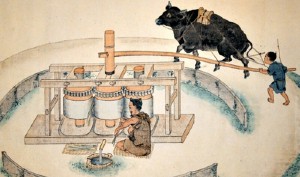
Sugar cane press. © National Museums in Berlin, Prussian Cultural Heritage, Museum of Ethnology. Photographer: Claudia Obrocki.
Item: Watercolor, sugar cane press
- Era: beginning of Meiji period
- Place of origin: Ryūkyū/Okinawa
- Material: paper
- Measure: 44,5 x 80,0 cm
- Ident.Nr. I D 7016
Addendum
The Motobu Udundi Facebook administrator just added a link to the Tokyo National Museum, showing a Akaji goshiki ukiori kan, or “headgear of red ground, interwoven with five colors of threads).
Item: Officials headgear of red ground, interwoven with five colors of threads
- Era: 19th century.
- Place of origin: Ryūkyū/Okinawa, Naha City Shuri-jō
- Material: silk, pigment
- Measure: Length 21.0cm, width 19.0cm, height 13.2cm.
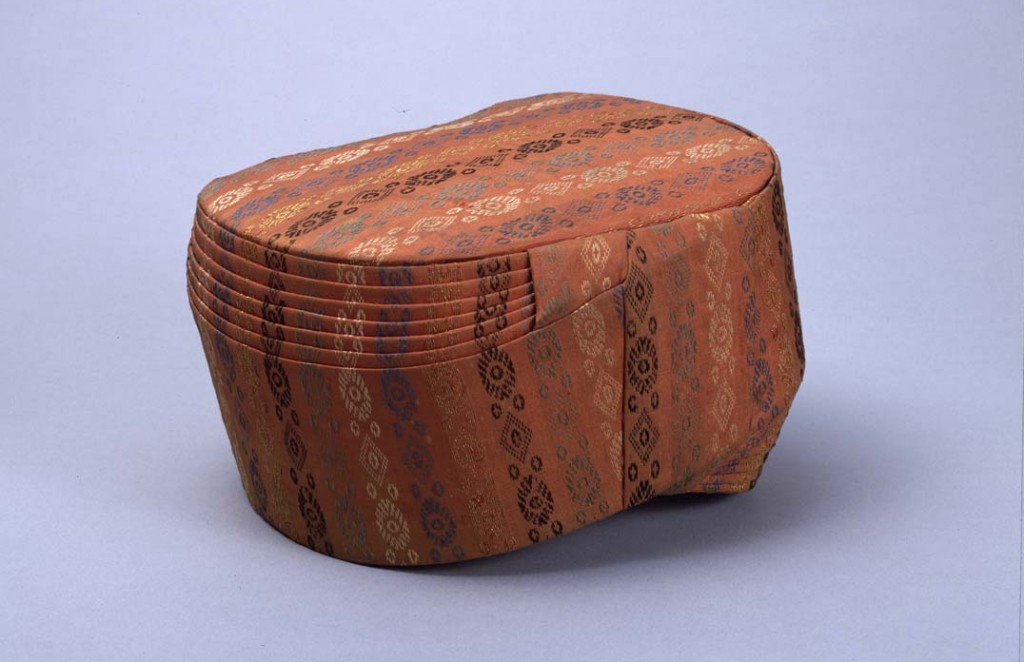
Akaji goshiki ukiori kan, or “headgear of red ground, interwoven with five colors of threads”. © Tokyo National Museum.
Recommended reading: Josef Kreiner (Ed.): Sources of Ryukyuan History and Culture in European Collections. Phillipp-Franz-von-Siebold-Stiftung, Deutsches Institut für Japanstudien, Monographien 13. Iucidium 1996.
© 2015, Andreas Quast. All rights reserved.
